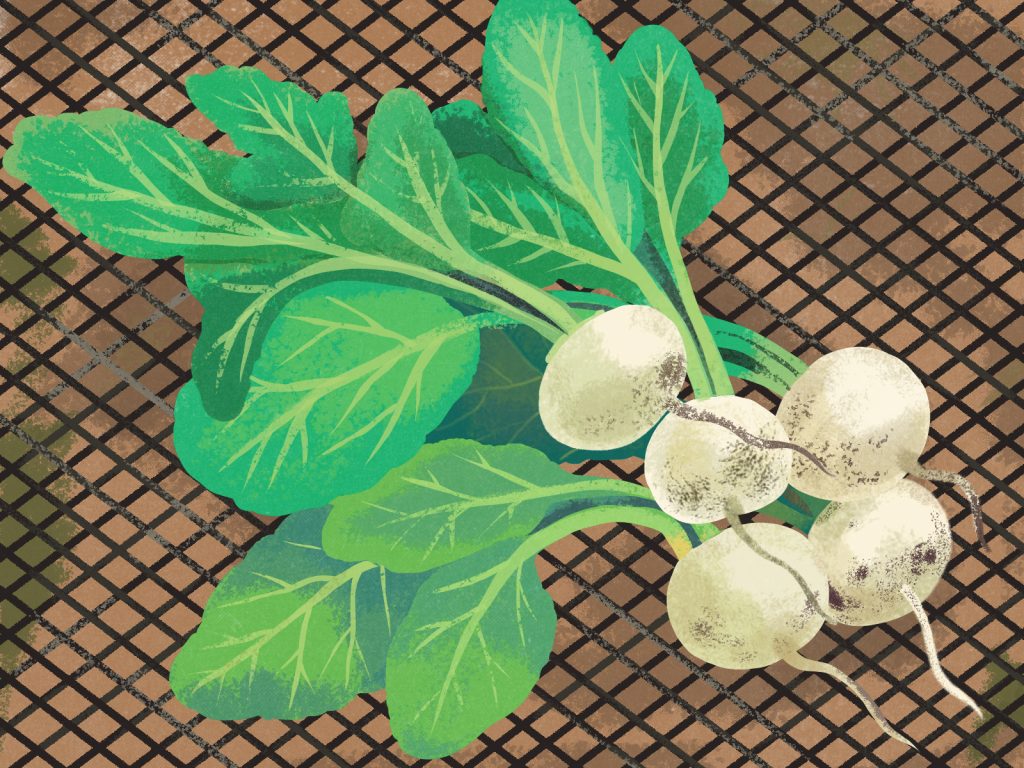Because of their focus on the passing seasons, haiku have long been rooted in ecological ways of thinking. Even when poets make humorous or philosophical observations, their insights are grounded in the careful observation of nature. Haiku poets assume that there is much to learn from watching a turnip. They know that the will of heaven and spring rain are one and the same. The winning and honorable mention haiku for last month’s challenge each tapped into those ecological ways of thinking—even when the poets were at their most playful.
- Marcia Burton finds that the turnip “starting over” at the back of her cupboard is playing the longest game there is.
- Nancy Winkler’s turnips are natural introverts—“reclusive” and rarely seen.
- Jesus Santos evokes a sense of melancholic wonder at the sight of a row of vegetables with their faces “buried in the soil.”
Congratulations to all! To read additional poems of merit from recent months, visit our Tricycle Haiku Challenge group on Facebook.
You can submit a haiku for the current challenge here.
Winter Season Word: Turnip
WINNER:
all but forgotten
a turnip in the cupboard
starts over again
— Marcia Burton
In 1972, when the environmental movement was still in its infancy, the United Nations convened the world’s first international conference to raise awareness about threats to global ecology. The official report of the Stockholm Conference included a passage that today reads almost like an eco-spiritual creed:
Life holds to one central truth—that all matter and energy needed for life moves in great closed circles from which nothing escapes and to which only the driving fire of the sun is added. Life devours itself: everything that eats is itself eaten; every chemical that is made by life can be broken down by life; all the sunlight that can be used is used. Of all that there is on Earth, nothing is taken away by life, and nothing is added by life—but nearly everything is used by life, used and reused in thousands of complex ways, moved through vast chains of plants and animals and back again to the beginning.
As human beings, it is easy to forget that we belong to that planetary equation, even though not one of us can stand apart from the matrix of biological blessings that the Earth provides. We eat . . . and we are eaten. It’s the oldest game there is, and everyone and everything is playing it. Even the turnip at the back of the cupboard.
Haiku often come at their subject from a slant. This month’s winning poem is no exception. The poet could have said that the turnip she forgot to cook has finally begun to rot. But where is the poetry in that? Where is the insight? Instead, she notes simply that it “starts over again.”
Our anthropocentric frame of reference sees the value of a thing in terms of its use specifically to human beings. When something rots, it goes in the refuse bin. Most people don’t even bother with compost. What happens to it after that is none of our concern. But its life is not over.
We bear witness to so little of those “great closed circles” that define life on Earth. The turnip continuing “through vast chains of plants and animals and back again to the beginning” eclipses our entire frame of reference. The opening line of the poem, “all but forgotten,” doesn’t refer just to the turnip, but to the world it travels through—a world that is much bigger, wiser, and more durable than our own.
HONORABLE MENTIONS:
you don’t see turnips
such reclusive vegetables
introverts, maybe
— Nancy Winkler
rows of white turnips
their identical faces
buried in the soil
— Jesus Santos
♦
You can find more on February’s season word, as well as relevant haiku tips, in last month’s challenge below:
Winter season word: “Turnip”
Turnip in my hand—
its cold roundness heavier
than a baby’s head
— Sister Benedicta O.S.H. (1936-2022)
Submit as many haiku as you wish that include the season word “turnip.” Your poems must be written in three lines of 5, 7, and 5 syllables, respectively, and should focus on a single moment of time happening now.
Be straightforward in your description and try to limit your subject matter. Haiku are nearly always better when they don’t have too many ideas or images. So make your focus the season word* and try to stay close to that.
*REMEMBER: To qualify for the challenge, your haiku must be written in 5-7-5 syllables and include the words “turnip.”
Haiku Tip: Enter a yearly contest!
Founded in 1975, the California-based Yuki Teikei Haiku Society takes its name from a popular approach to writing haiku in modern-day Japan. Yuki means “with season,” while teikei means “having formal pattern.” Taken together, the words describe the two most familiar elements of haiku: the 5-7-5 syllable pattern and the use of season words. Since 1978, the society has sponsored an annual contest for formal haiku in English, for which the season words are pre-assigned.
In addition to the poems that you submit for our Tricycle Challenge this month, to hone your skills, you may wish to review the season words for the contest and write haiku on any that resonate with you. From among those poems, choose your favorites to send to the contest following the submission guidelines on the society’s website. The deadline is May 31.
The Yuki Teikei approach to writing haiku was pioneered by Takahama Kyoshi (1874-1959), the most influential haiku editor of the 20th century. Kyoshi wrote haiku as an objective sketch from nature and encouraged others to do the same. His “just-the-facts” approach to poetry became part of the DNA of modern haiku, and every poet can benefit from learning to write this way. Yuki Teikei haiku teach us how to convey subtle thoughts and feelings without stating them directly, relying on the images to speak for themselves.
This month’s sample haiku offers a fine example. Some background about Sister Benedicta may be helpful in understanding the simple, but strangely powerful imagery of her poem.
Born Andrea Sender in 1936, Sister Benedicta’s father was one of the most acclaimed Spanish novelists of the 20th century. In July of 1936, Ramón José Sender was vacationing with his family when the civil war broke out. Sender escaped on foot over the mountain to join the militia, leaving his wife and children behind, believing the nationalists would not harm them.
It was a tragic blunder. Amparo Barayon was imprisoned and later executed in a graveyard by a man whose advances she had spurned some years earlier. The atrocity was reported in newspapers around the world, but it contained one inaccuracy: It was said that Amaparo’s infant daughter Andrea, imprisoned along with her mother, had died because she refused to eat after her mother was shot.
A few years before Benedicta wrote this poem, in a retrospective article about the Spanish Civil War, the New York Times again reported on her death as an infant. It was one of those mistaken historical details that takes root in the collective public imagination and simply refuses to come out.
Benedicta’s turnip haiku took first prize in the contest sponsored by the Yuki Teikei Haiku Society in 1994. Not that I was surprised. The judge, a Japanese haiku master, wrote: “At some time in her life the poet must have cradled a dead baby in her arms.”
Knowing something of Benedicta’s life as a nun, this could have been true, so I asked her. But she said no. She was having trouble figuring out what to do with any of the season words on the list that year when, opening the refrigerator in the convent refectory one night, she saw a turnip. She took it out and held it in one hand, whereupon the comparison to a baby’s head had instantly sprung to mind. She wasn’t sure where it had come from.
Benedicta was overwhelmed with emotion when I told her what I thought about her haiku. That the baby was her—the part of her that died in that prison in Zamora the night her mother was dragged out to the graveyard and shot. The newspaper account hadn’t been correct about the facts. But it also hadn’t been wrong.
I have since come to believe that the best haiku come this way—that we write them from a place inside of ourselves that lies well below the conscious level of our minds. The images themselves are objective, but they open a window on the soul.
A note on turnips: Turnips are grown in temperate regions worldwide, both for their fleshy, white taproot and the vitamin-rich greens of their stems and leaves. Because they store well, they are often consumed from late fall through winter. Beginning around 4,000 years ago, turnips were cultivated from the Mediterranean to India. They eventually spread to China and then to Japan around 700 C.E. Turnips have long been used in animal fodder and were sometimes the only crop left during times of famine, although their nutrients—unlike the potato—are not sufficient to sustain human life.
Thank you for subscribing to Tricycle! As a nonprofit, we depend on readers like you to keep Buddhist teachings and practices widely available.

